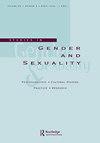To Tell the Truth, (Re)Tell One’s Tale: On Pedophilia, Taboo Desire, and Seduction Trauma-- Introduction to The Tale and Leaving Neverland: A Panel on Two Films on Childhood Sexual Abuse
Q3 Social Sciences
引用次数: 1
Abstract
ABSTRACT Our introduction is to a panel that considers two films, The Tale and Leaving Neverland. Both films feature adult protagonists reclaiming memories of their disavowed childhood sexual abuse, and both were released amid #MeToo and a proliferation of other films, TV shows, and memoirs depicting seduction trauma in the context of a family romance plotline. Together, they suggest features of a universally taboo story (of childhood sexual abuse), compounded by psychoanalysis’s primal taboo: incestuous desire. It is argued that though psychoanalysis recognizes the reality of sexual abuse, it nonetheless seems to discount, as did Freud, its ubiquity, and, too, may leave underexplored the incidence of pedophiliac fantasy. Further, and ironically in light of psychoanalysis’s history, it underestimates the survivor’s investment in her romantic fantasy, and its identification itself with her aggressor’s “grooming,” as a force that denies the real of her trauma. Both films depict the ongoing therapeutic action of après-coup, in the quest to (re)tell truth between memory–desire, omnipotence–agency, truth–fiction, and reparation–(imaginative) apology.说实话,(再)讲述一个人的故事:恋童癖,禁忌欲望和诱惑创伤——故事介绍和离开梦幻岛:两个关于儿童性虐待的电影小组讨论
摘要我们的介绍是一个小组,考虑两部电影,故事和离开梦幻岛。这两部电影都讲述了成年主人公回忆起他们否认的童年性虐待的故事,这两部影片都是在《#我也是》和其他电影、电视节目和回忆录泛滥之际上映的,这些电影、电视剧和回忆录都描绘了家庭爱情情节中的诱惑创伤。总之,它们暗示了一个普遍禁忌的故事(关于童年性虐待)的特征,再加上精神分析的原始禁忌:乱伦欲望。有人认为,尽管精神分析认识到性虐待的现实,但它似乎和弗洛伊德一样,低估了性虐待的普遍性,而且可能会使恋童癖幻想的发生率得不到充分的探索。此外,具有讽刺意味的是,鉴于精神分析的历史,它低估了幸存者对其浪漫幻想的投资,以及其对侵略者“打扮”的认同,认为这是一种否认其创伤真实性的力量。这两部电影都描绘了政变的持续治疗行动,在记忆——欲望、无所不能——代理、真相——虚构和赔偿——(富有想象力)道歉之间寻求(重新)说出真相。
本文章由计算机程序翻译,如有差异,请以英文原文为准。
求助全文
约1分钟内获得全文
求助全文
来源期刊

Studies in Gender and Sexuality
Social Sciences-Gender Studies
CiteScore
0.80
自引率
0.00%
发文量
15
期刊介绍:
Beginning in the final two decades of the 20th century, the study of gender and sexuality has been revived from a variety of directions: the traditions of feminist scholarship, postclassical and postmodern psychoanalytic theory, developmental research, and cultural studies have all contributed to renewed fascination with those powerfully formative aspects of subjectivity that fall within the rubric of "gender" and "sexuality." Clinicians, for their part, have returned to gender and sexuality with heightened sensitivity to the role of these constructs in the treatment situation, including the richly variegated ways in which assumptions about gender and sexuality enter into our understandings of "normality" and "pathology."
 求助内容:
求助内容: 应助结果提醒方式:
应助结果提醒方式:


